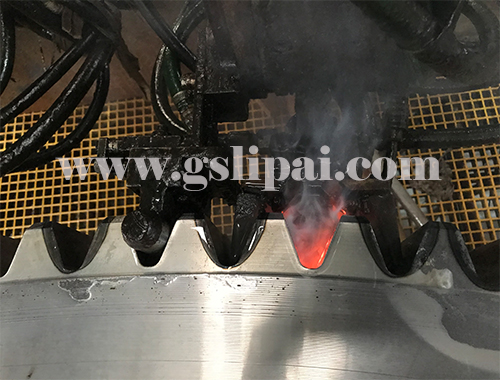1. Insufficient hardness and insufficient hardening depth
The low quenching cooling rate is the cause of insufficient quenching hardness, uneven hardness and insufficient hardening depth. However, according to the actual hardened gear material, shape and size and heat treatment requirements, it can be divided into high temperature stage, insufficient cooling rate, medium and low temperature There are different situations such as insufficient cooling rate in the stage and insufficient cooling rate in the low temperature stage. such as. For small and medium gears, insufficient quenching hardness is often caused by insufficient cooling speed in the middle and high temperature stages. When gears with large modulus require a deeper hardened layer, it is very necessary to increase the low temperature cooling rate.
For quenching oil, generally speaking, the oil has a short vapor film stage, a fast cooling rate at medium temperature, and a fast cooling rate at low temperature, which can often obtain high and uniform quenching hardness and sufficient quenching depth.
The way the workpiece is mounted also has a significant impact on the quenching cooling effect. It is necessary to make the quenching oil flow unobstructed, and to equip and use a good mixing device to get a better effect.
Increasing the low-temperature cooling rate of the quenching medium used can often increase the depth of the hardened layer. In the case of the same carbon concentration distribution in the carburized layer, the use of a quenching oil with a higher low-temperature cooling rate often results in a deeper quenching hardened layer. Therefore, the use of a quenching oil with a faster cooling rate can shorten the carburizing time of the workpiece correspondingly. Can obtain the required depth of quenching and hardening layer. The greater the depth of the carburized hardened layer required, the more obvious the effect of this method in shortening the carburizing time.
2. Hardness of the core after quenching is too high
Such problems may be related to the excessively fast cooling rate of the selected medium or the excessively high low-temperature cooling rate of the medium. One of the solutions is to change the quenching oil to meet the requirements. The second method is to contact the quenching medium manufacturer and add appropriate additives to reduce the cooling rate of the quenching oil. The third method is to switch to steel with lower hardenability.
3. Quenching deformation problem
Quenching deformation has made many factories brain-wrenching. According to custom, the solution to the deformation problem usually involves multiple departments, and the solution is often a comprehensive measure.
The main reason for the deformation is attributed to insufficient cooling rate and uneven cooling, and on this basis, a solution to increase the cooling rate and try to achieve uniform cooling is proposed. Increasing the quenching cooling rate can solve most of the quenching deformation problems of gears. . For example, the deformation of the inner spline hole of the gear is often due to the insufficient high-temperature cooling rate of the selected quenching oil, or the excessively long vapor film stage of the oil. Increasing the high-temperature cooling rate of the oil and increasing the cooling rate of the oil in the entire cooling process can generally solve the problem of deformation of the inner spline hole. For small and medium gears, especially the more precise gears, a good selection of isothermal graded quenching oil is an indispensable measure to control deformation.
4. Quenching and cracking of gears
Choose a good water-based quenching medium, such as the PAG quenching medium commonly used at home and abroad (such as Jinyu 8-20 produced by Beijing Huali Fine Chemical Co., Ltd.) instead of the original tap water, and the problem is solved. PAG medium is used for induction heating and quenching. High and uniform quenching hardness and deep and stable hardened layer can be obtained, and the risk of quenching cracking is extremely small.
5. Light problem
Should choose bright quenching oil or fast bright quenching oil. Generally, the cooling rate of bright quenching oil is not high enough if the brightness of the bright quenching oil is good, and the brightness of the quenching oil with a high cooling rate is not good enough. In addition, the brightness of hot oil is generally poor. You can change the oil or add additives to improve the brightness.




 en
en  cn
cn  jp
jp  ko
ko  de
de  es
es  it
it  ru
ru  pt
pt  vi
vi  th
th  pl
pl 







 GS-ZP-1200
GS-ZP-1200


